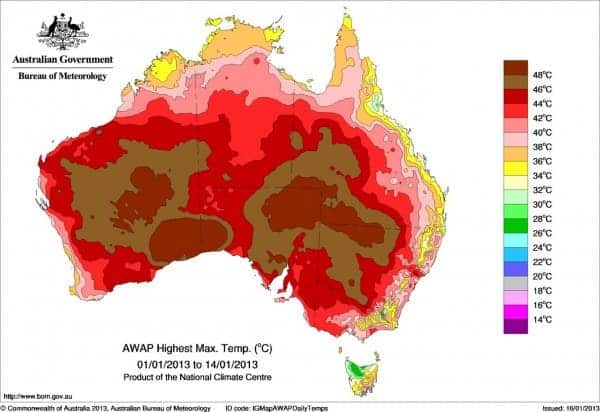Australia went through two almost unbearable consecutive summers. Of course, Australia is a naturally hot country, but the temperatures were extremely high even for them. Record temperatures were recorded and heat waves swept throughout the entire country. Now, five separate studies published today conclude that the blazing summers can be blamed on man-made climate change.
Sizzling Hot

The January 2014 southeastern Australia heat wave was a significant heat wave event which affected most of southeastern Australia from 13 to 18 January 2014. In 2013 the situation was even worse, as most of the country had temperatures of over 42 degrees Celsius (107 Fahrenheit). This spike in heat waves comes in the context of record breaking high temperatures across Australia over the past five years which have spurred heated discussions regarding man-made climate change. Are we to blame for the heat waves in Australia?
No less than five separate papers, all part of a grander report concluded that the answer is ‘yes’. Explaining Extreme Events of 2013 From a Climate Perspective, published in the Bulletin of the American Meteorological Society (BAMS) features a total of 22 separate studies focusing on 16 different extreme weather events that occurred last year. However, aside for the Australian heat waves, researchers couldn’t find a connection between man-made climate change and extreme weather events. This doesn’t necessarily mean that the connection doesn’t exist – the matter is so complex that a direct link is often times extremely hard to find. However, for the particular cases in Australia, the link is clear.
“When we look at the heat across the whole of Australia and the whole 12 months of 2013, we can say that this was virtually impossible without climate change,” said David Karoly, a climate scientist at the University of Melbourne who led some of the research.
The study relied on computer models to show how the climate would have been in the absence of human emissions. This type of research is widely known to be imperfect, and sometimes yields conflicting results – but in this case, scientists were surprised to observe the unanimity of the results. Basically, no matter how you parametrize the model, the result is the same: without human emissions, there would have been now heat waves. Results convinced even skeptics:
“The evidence in those papers is very strong,” said Martin P. Hoerling, an American scientist with the National Oceanic and Atmospheric Administration who has often been skeptical of claimed links between weather events and global warming.

Two traps
Climate scientists have often argued that even if extreme weather events weren’t directly caused by climate change, their effects are likely accentuated by it. Again, this issue is hard to demonstrate, and it’s rare that climate models reach a consensus. For example, in the same report, the California drought was also analyzed. The models agreed that man-made climate change wasn’t the cause of it, but they disagreed on whether or not it was accentuated by global warming. Some results indicated ‘yes’, some indicated a ‘no’.
There are two traps which we must avoid here – first of all, we shouldn’t point the finger at climate change for every freak weather event. Extreme weather has happened before and it will happen in the future. Humans might be responsible for some events, but even without us, there would still be freak weather. The other trap is even more dangerous. It implies not doing anything, simply because there is no certainty. Let’s sum up what we know: climate change is happening; it’s real, and we’re causing it. There is a scientific consensus on the issue, there’s little discussion there. Whether or not extreme weather is associated with it, that’s a different story. As dire as it sounds, there are far worse implications than that.






